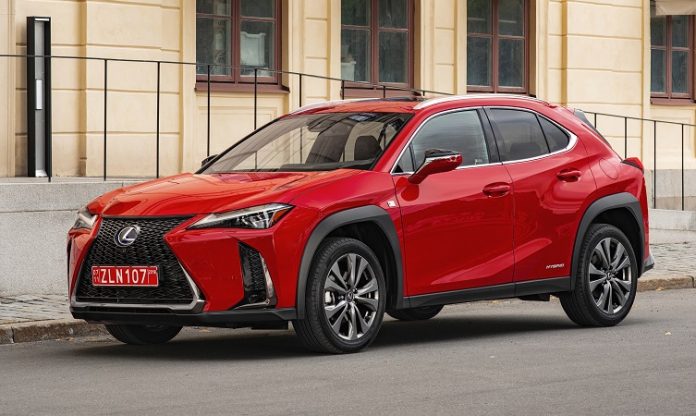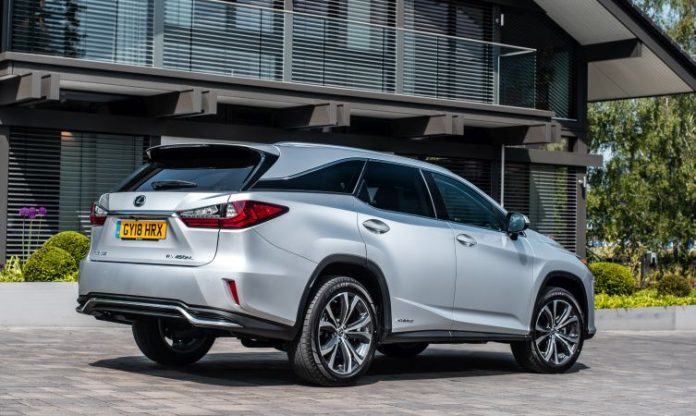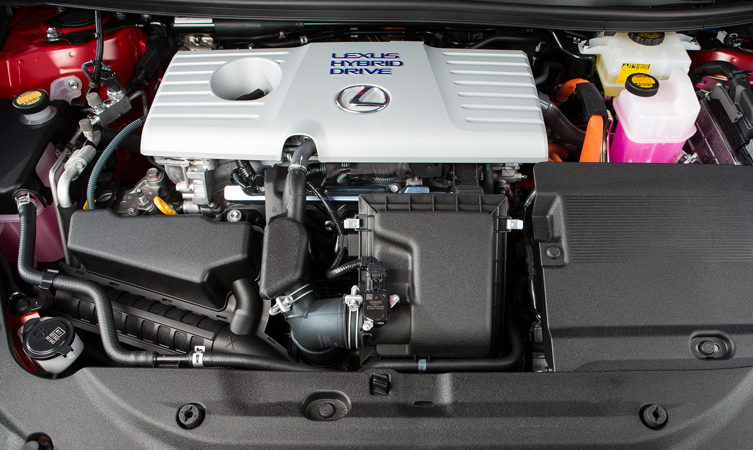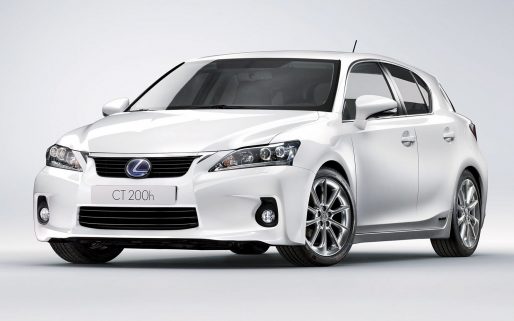The Lexus vehicle range comprises ten lines and thirteen individual models, some of which can be specified with different powertrains. Here you will find information on each powertrain and its availability within the range.
Powertrain: 200h
The number ‘200’ references the fact that the power output is equivalent to a conventional 2.0-litre petrol engine, while the ‘h’ stands for hybrid – a combination of both internal combustion and electric power sources.

The 200h powertrain is the sole engine option for the CT range. It consists of a 1.8-litre four-cylinder 98bhp Atkinson cycle petrol engine (code 2ZR-FXE) mated to an 81bhp electric motor.
Total system output is 134bhp and the 0-62mph sprint time is 10.3 seconds. Top speed is 112mph and CO2 emissions range from 97 to 101g/km. Combined fuel economy figures range from 64.2 to 67.3mpg.
Powertrain: 250h
The number ‘250’ references the fact that the power output is equivalent to a conventional 2.5-litre petrol engine, while the ‘h’ stands for hybrid – a combination of both internal combustion and electric power sources.

The 250h powertrain is the sole engine option for the UX range in the UK. It consists of a 2.0-litre four-cylinder 144bhp petrol engine (code M20A-FXS) mated to a 108bhp electric motor generator.
Total system output is 176bhp and the 0-62mph sprint time is yet to be confirmed. Top speed, emissions and fuel economy figures are also yet to be confirmed.
Powertrain: 300h
The number ‘300’ references the fact that the power output is equivalent to a conventional 3.0-litre petrol engine, while the ‘h’ stands for hybrid – a combination of both internal combustion and electric power sources.

The 300h powertrain is the most widely applied across the Lexus range, available in the IS, ES and GS saloons, NX crossover and RC coupe. It always consists of a 2.5-litre four-cylinder petrol engine mated to a 141bhp electric motor, however there are marginal differences across the five ranges.
The engine in IS, GS and RC models (code 2AR-FSE) produces 178bhp for a total system output of 220bhp, while the closely related engine in NX (code 2AR-FXE) is tuned to produce 153bhp for a total system output of 195bhp. The newest iteration is the all-new engine in ES (code A25A-FXS), which combines a fourth-generation hybrid system to produce a total system output of 215bhp.
As the smallest and lightest model, the IS returns the best overall figures for a vehicle with the 300h powertrain: 8.4 seconds to 62mph, 125mph top speed, combined fuel economy of up to 65.7mpg and as little as 101g/km of CO2 emissions.
Powertrain: 450h
The number ‘450’ references the fact that the power output is equivalent to a conventional 4.5-litre petrol engine, while the ‘h’ stands for hybrid – a combination of both internal combustion and electric power sources.

The 450h powertrain is applied across two models in the Lexus range: GS saloon and RX crossover. It consists of a 3.5-litre V6 petrol engine (code 2GR-FXS) mated to an electric motor/s, however due to the different natures of each vehicle there are differences in the outputs of each element.
In the RX and RX L, the petrol engine delivers 259bhp, while the front and rear electric motors produce 165 and 68bhp respectively. This creates a combined system output of 308bhp. However, in the GS, the petrol engine delivers 288bhp, while the electric motor produces 197bhp for a total system output of 341bhp.
The performance-oriented GS 450h sprints to 62mph in 5.9 seconds and reaches a maximum speed of 155mph. It can produce as little as 141g/km of CO2 and a combined fuel efficiency figure of 46.3mpg. Meanwhile, the full-size RX crossover is not far behind, offering best figures of 7.7 seconds to 62mph and 124mph top speed, allied to 48.7mpg economy and 132g/km emissions.
Powertrain: 500
The number ‘500’ references the fact that the petrol engine has a 5.0-litre displacement. When the designation is missing the letter ‘h’ the powertrain is naturally aspirated and not a hybrid.

The 500 powertrain is one of two options in the flagship LC coupe range. It refers to a 5.0-litre V8 petrol engine (code 2UR-GSE) that produces 471bhp.
The engine catapults the LC 500 to 62mph in 4.4 seconds and on to a top speed of 168mph. Its combined fuel economy figure stands at 24.6mph and it produces 263g/km of CO2 emissions on 20-inch wheels.
Powertrain: 500h
The number ‘500’ references the fact that the power output is equivalent to a conventional 5.0-litre petrol engine, while the ‘h’ stands for hybrid – a combination of both internal combustion and electric power sources.

The 500h powertrain is applied across two models in the Lexus range: LC coupe and LS flagship saloon. It consists of a 3.5-litre V6 petrol engine (code 8GR-FXS) producing 295bhp mated to a 177bhp electric motor. The total system output of both models is 354bhp.
Both models offer a top speed of 155mph, though the LC is the quicker to 62mph at 4.7 seconds compared to the 5.4 seconds of the LS. There is even less separating the pair in terms of best economy and emissions figures: 44.1mpg and 145g/km for the LC, and 43.5mph and 147g/km for the LS.
Wild card: F models
Lexus F models have never offered any outward indication of engine size, although all four models – IS F, LFA, RC F and GS F – have been equipped with large capacity, naturally aspirated V-configuration engines.

Smallest in terms of displacement but the largest in terms of power and cylinder count is the 553bhp bespoke 4.8-litre V10 (code 1LR-GUE) of the Lexus LFA supercar.
Meanwhile, the IS F, RC F and GS F feature essentially the same hand-built 5.0-litre V8 (code 2UR-GSE) shared with the LC 500. Over the years its output has been refined and improved to the 471bhp of today’s RC F and GS F models.





Eliott, i will be particularly interested in the 200t engine. I know it will be next launched in the RC designated as RC200t. Two questions…
Would you be able to confirm, or speculate if the engine will be tuned ‘up’ for the RC to say 250hp+?
And it would be an excellent car if that resulted in a sub 6 seconds 0-60. What do you think?
I expect you will only tell me to ‘watch this space’
Hi Rob
Thanks for your post and for your interest in the 200t.
The honest answer is that we do not know just yet. If this model had gone on sale in the US for example then we might have been able to use the figures as a guide. We certainly agree with your comments about the 0-60 but we would not like to speculate that the engine would have an increased power output. We will be sure to put the latest news on our Blog but let us know if you have any other questions.
There seems to be a typo: the LS600h does have a 5.0-litre V8 petrol engine, NOT a 4.5-litre V8 petrol engine
Hi New
Thanks for your post and well spotted!
You are correct of course as the LS 600h does have a 5.0-litre V8 engine (4,969 cc to be exact). We have updated the post accordingly.
I have a 2013 is250 fsport with according to Lexus paperwork engine 4gr0113427. Can you please identify this engine for me, is this a Direct Injection only engine ?
Helo Michael, thanks for your comment.
Please provide your Vehicle Registration so that we can look into this.
Thanks.